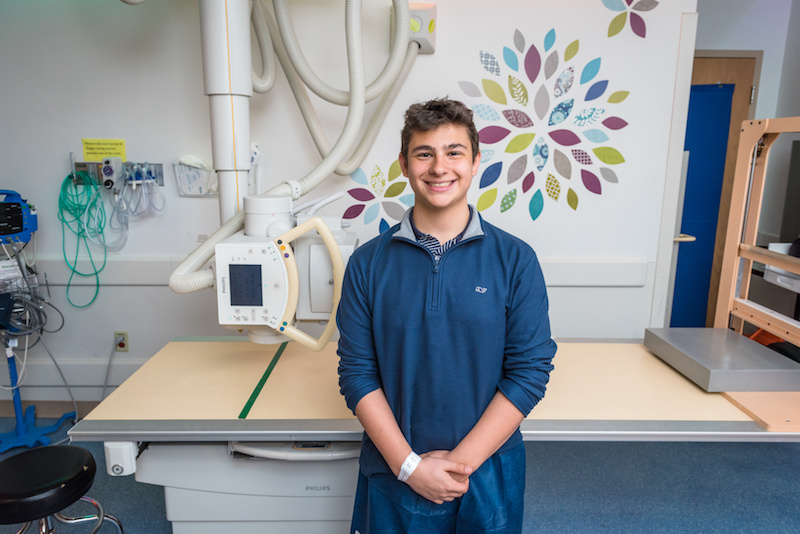Limb-salvage surgery is best option for Andrew

It was quite a spring for Andrew Hedberg. The rising high school sophomore made the varsity golf team and was elected class president for the upcoming school year. Most importantly, the bone cancer that once threatened his left leg and his life remained in remission.
All of this validated the decision that Andrew’s family made seven years ago, after pain in his lower leg led to a diagnosis of osteosarcoma, the most common type of bone cancer among children, adolescents, and young adults. In addition to chemotherapy and radiation, orthopedic specialists in the Bone and Soft Tissue Tumor Program at Dana-Farber/Boston Children’s Cancer and Blood Disorders Center offered two surgical options: limb-salvage surgery or rotationplasty — a partial amputation that preserves a cancer-free lower leg by re-attaching it to the patient’s thighbone, using the ankle as a knee joint.
Rotationplasty allows a child to maintain a very active lifestyle, including the opportunity of playing high-impact sports such as football and hockey, because the reattached ankle working in conjunction with a prothesis allows for flexibility and durability. Limb-salvage surgery preserves a leg’s function, and its pre-surgical appearance, but because wide margins of normal tissue need to be removed in addition to the tumor, the risk of fracture from a strong blow increases. High-impact sports are out, but there is no need for a prosthetic leg.
Making the choice
Seven years ago, Andrew was too young to fully understand the important choices. After consulting with his medical team, led by orthopedic surgeon Dr. Mark Gebhardt and oncologist Dr. Katherine Janeway, his parents elected for limb-salvage surgery to preserve their son’s full leg.
“Dr. Gebhardt felt limb-salvage surgery would be the best option for Andrew,” says Karen Hedberg, Andrew’s mother. “It would be easier for Andrew to handle while he grew up.”
Collaboration between his orthopedic surgery and oncology teams was critical for Andrew prior to and after his surgery. In addition, the nursing staff, physical therapists, and other clinicians were instrumental in helping him get back onto his feet after his cast was removed and he began rehabilitating and strengthening his leg.

“There was a great partnership between Dr. Gebhardt and Dr. Janeway,” says Andrew’s dad, Fred. “They were transparent with us about what to expect, and they did an excellent job bringing Andrew into the discussion as much as possible.”
Life after surgery
While the surgery was a success, there were still challenges. The growth plates in Andrew’s left knee — areas of developing cartilage tissue near the ends of long bones in children and adolescents — had been hampered by the tumor just above them, causing his left leg to grow at a slower rate than his right. Three years ago, Dr. James Kasser performed additional surgery to slow the growth in Andrew’s right leg and lessen the discrepancy in length.
With time, Andrew has come to understand his physical limitations.
“Sure, there were times I wanted to play contact sports, but I’m making the most of things,” he says. “I can still shoot baskets or go to the batting cage, I just can’t play in actual games. And this past year I’ve really enjoyed playing golf and being a member of my high school golf team.”
Fred believes one reason his son has excelled at golf, despite only recently picking up the sport, is all the time Andrew spent hitting baseballs he tossed to him in the years before and after his surgery. The great hand-eye coordination he developed from swinging a baseball bat translated into a strong golf swing. His doctors are thrilled.
“There is still a risk of getting hurt,” Andrew says. “But you can’t live in fear.”
Learn more about treatment for osteosarcoma from Dana-Farber/Boston Children’s.
Related Posts :
-

Questions to ask about your child’s orthopedic care
Maybe your child has an orthopedic injury and needs surgery, or maybe they need to be treated with a different ...
-

Exposing a tumor’s antigens to enhance immunotherapy
Successful immunotherapy for cancer involves activating a person’s own T cells to attack the tumor. But some tumors have ...
-

Combining CAR-T cells and inhibitor drugs for high-risk neuroblastoma
Chimeric antigen receptor (CAR)-T cell therapy is a potent emerging weapon against cancer, altering patients’ T cells so they ...
-

Could a GI bug’s toxin curb hard-to-treat breast cancer?
Clostridium difficile can cause devastating inflammatory gastrointestinal infections, with much of the damage inflicted by a toxin the bug produces. ...





